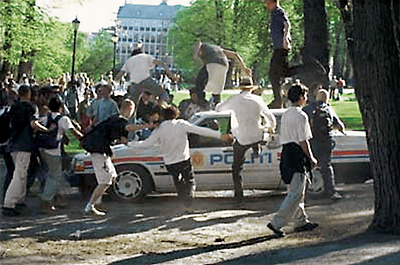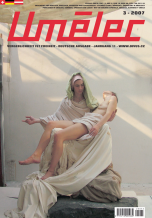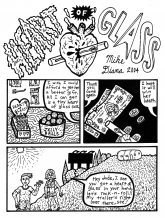|
Simon Sheikh: A recurrent theme in your work has been the usage, representation and perhaps even psychology of architecture. On the one hand you seem interested in the surface of buildings, their reflections but also deferrals of gazes, of desires and usages, and on the other hand you seem committed to the everyday, to other practices in other spaces, often connected to the apparently invisible, the nighttime or dark side, but also to the pleasurable and the desirous. This touches on the relationship between the formal and the political at play in modern architecture: Units are designed for specific functions, institutions and modes of being, and thus for producing and inducing certain patterns of behavior and even subjectivity. It is a social design, or aesthetics for living. Modern architecture uses a particular strategy of compartmentalization, simply put: distinguishing between spaces of production, living and leisure. This also leads to a compartmentalization of subjectivity. A mapping of the city into different areas of desire is a parallel to an idea of mapping the body, structuring it into different zones of desire. But the body always leaves residues - desire and behavior are not evenly structured - and the same happens to the flows of the city space. I think you described it as "Order in the streets leads to disorder in our minds", and I am wondering about this relation: How compartmentalization leads to a certain schizophrenia? |Knut ?sdam: Well disorder could also mean states other than schizophrenia, for example, a state of paranoia that is often seen as close to totalitarian and fascistic desire. What has been useful for me with Foucault and schizo-analysis is that they point to an understanding of place and space as political and processual, in a way that is applicable to our times. I know my work is very informed by both Foucault and Deleuze & Guattari, but not more so than to Kristeva, DeCerteau, Delaney, Negri or Crimp. But you can then perhaps trace an interest for a political commitment.|In the film Filter City I have tried to tie the sense of loss of direction to a sense of loss of direction in the language of the characters themselves. So basically through the structure of the film I want to make a symbiosis between the external and internal for the subjects at play. The sentence you quoted is an anonymous grafitti from Paris '68 that I again have taken from DeCerteau. It is a wonderful, even "ideal" piece of grafitti, showing a need for the disorder on the skin of the city that it is in itself. However, it is tragic that we have in the end of the 1990's and in an accellerated fashion, in the beginning of the 2000's, a growing sense of societies of control. Deleuze's text Postscript on Societies of Control seemed at a point in the beginning of the 1990's a bit quaint or old fashioned in its analysis. While it is today so contemporary, Postscript is in a sense a good prescript to the current understanding of Empire too. I guess it took the early 2000's for me to realize that we were indeed in postmodern territory. I had until then seen us as in nothing but a reiteration of modernism. Now we see Empire clearly as a very postmodern reactualisation and reworking of imperialism. As much as there are growing movements for political activism and focussed production among cultural producers and among normal people, there is also a sense of a really difficult struggle with power. Perhaps a struggle that seems so unattainable, unwinnable and hard to feel impact on as the class struggles of the late 1800's and early 1900's. The agencies of power are so far removed from the people that one is faced with a near collapse of language or the desire to speak. These are some things I try to deal with in Filter City, and that in one of the characters, O, leads to a melancholy or depressed speech, an ensnarling and apathetic speech that totally fails to communicate with others. In the other main character, S, the same confrontation results in a desperate search for meaning and articulation in her realtionship to others: a search for other possibilities for herself -- including other fictive friends/lovers. The architecture here is very dominant in the film. It represents something that changes slowly but still fast enough to represent, exclude and include from the economic and political fluctuations of a city. For the protagonists of my film its change is out of control. If there is a dynamism then, between the two, it is rather one directional -- the subjects here are subjected to their city environment and its processes of economic and social restructuring -- but of course what that means to them as 'subjects'is to a certain degree up for grabs -- and that is what they are struggling to make sense of.|SS: In one of your earlier works, Come to Your Own, you employ the language of the hypnotist, where, at the end of a session, the person addressed has to come out of the altered state. The video uses language as a structuring tool, a command, and, finally, as a becoming: The person adressed has to come to his or her own. I am curious as to your use of language as becoming, I think there is a usage here that is not exclusively narrative, but -- through the 'poetic' language -- perhaps also formative of the subject.|K?: The promise to "come to your own" in this particular video points to an impossibility that is nevertheless promised. This forms a deadlock in the video where what is promised -- the (impossibility of) coming to one's own in a terminated bodily identity -- is more and more displaced as the viewer is drawn into the repetitive and slightly hypnotic mentioning of affect. I guess my use of language is highly influenced by the idea of the performative within the gender theory of Judith Butler, where the subjectivities are articulated as a complex and temporal effect and play of language. Since I am not posing a singular subject in my work, my use is rather to employ language as formative, and as a repetitive inscripition of subjectivities, desires and struggles. I use poetic and narrative language to set up relations between presumed subjects and architectural, social, sexual or economic environments. This allows me to use a form of language that is not didactic and clearly involves desire. It also allows for humour and subtle plays on the serious, committed and the pathetic, as well as to use language for including a contemporary play on age, place etc. |SS: The relation between coming and going is also evident in Untitled: Pissing, where on the one hand something is definetely being let go, but the close-up, or crotch-shot, also sexualizes the image; and refers to coming in the sense of cum. The phallus, here, is at once ridiculed and reified, I think. The image can also be read as auto-erotic, as a sexuality that is inwardly directed rather than outwardly projected. It is a sexual image that rejects the gaze of desire as much as it invites it. How does this image relate to your circumscription of the phallus, of heterosexual masculinity, and to your reading and employment of queer theory?|K?:If we are talking about Untitled: Pissing in particular, it was strongly motivated by queer theory on the one hand and by a reaction to all the abject masculinity work that was being produced at that time (early mid 90's) -- and that, in my opinion, just affirmed the compulsory hetereosexual order it was purporting to criticise. I wanted to make a work that was affirmative of masculine sexuality as a 'possibility' and that opened up the terms of that masculinity, multiplying the sexual identifications without priority for one or the other in the work. I wanted to make a work that produced a notion and relation of sexuality that was different from the powerful and dominant relic that is reiterated so much from all the heterosexual male-abject work. As much as the act within the work, to piss on one self, is traumatic in relation to the adult masculinity -- there is in that an element of celebration -- and that touches onto what you mention as the autoerotic within the work.|Queer theory and feminism have laid a basis for the way I am attempting to deal with subjectivity in my work at large, even though sexuality or gender might not be the main focus in the work. This is of course not an academic concern, but something that comes out of experience and everyday living. These are after all relations that meet us every day of our lives, and that we have to relate to knowingly or not, willingly or not. Growing up in 1970s Scandinavia feminism had set a stage for the discussion of what it meant to be a boy, girl, woman or man -- a discussion somehow everyone had to participate in regardless of your stand. But this also meant that we were able to think about womanhood or masculinity in terms of possibilities, not just as 'fixed inheritance'. I really don't understand why so many straight people have problems with the discussion of masculinity informed by queer theory and feminism, after all it opens up the possibilities of what sexuality and relations you can produce as male -- also as a heterosexual male. As saturated as this is into every little nook and cranny of our societies -- gender and sexual roles, law, advertising, media, architecture and even bureaucratic structures. As much as it affects people in the every day, these are essential projects to continue.|My works cannot tell you a lot about sexuality perhaps, but they try to deal with subjectivities that question the way we perceive and experience power and social space. I am also interested in working with how we internalize gender and sexual norms within our own systems of desire.|Dealing with masculinity also led me to work through many of the notions of space and architecture. In the early and mid 1990s with work like Abyss: striated space, smooth space and the beginning of the Psychasthenia series, queering architecture was at the forefront, the main thematic of the work. It then became part of the basic vocabulary of the work: the method of articulating and activating space. What has been important to me is to have an understanding of the structural work of issues of sexuality and gender -- as a segmentation of these topics' histories. Then what is important is to understand -- as we have touched into many times in our discussions -- the performative and processual nature of this; the temporality and repetition at stake. How a space or an attitude has to be reinscribed in order to present a 'stable' meaning.|
Recommended articles

|
|
Author dreaming of a future without censorship we have never got rid of.
It seems, that people don‘t care while it grows stronger again.
|

|
|
Contents of the new issue.
|

|
|
Nick Land was a British philosopher but is no longer, though he is not dead. The almost neurotic fervor with which he scratched at the scars of reality has seduced more than a few promising academics onto the path of art that offends in its originality. The texts that he has left behind are reliably revolting and boring, and impel us to castrate their categorization as “mere” literature.
|

|
|
Goff & Rosenthal gallery, Berlin, November 18 - December 30, 2006
Society permanently renegotiates the definition of drugs and our relationship towards them. In his forty-five minute found-footage film The Conquest of Happiness, produced in 2005, Oliver Pietsch, a Berlin-based video artist, demonstrates which drugs society can accommodate, which it cannot, and how the story of the drugs can be…
|
|














































 New book by I.M.Jirous in English at our online bookshop.
New book by I.M.Jirous in English at our online bookshop.
Comments
There are currently no comments.Add new comment